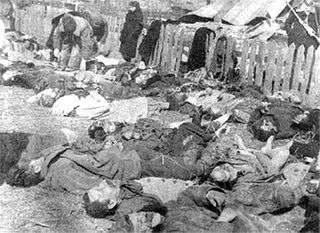Ponary massacre
| Ponary massacre | |
|---|---|
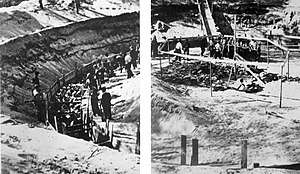 One of six Ponary murder pits in which victims were shot (July 1941). Note the ramp leading down and the group of men forced to wear hoods. | |
| Also known as | Polish: zbrodnia w Ponarach |
| Location | Paneriai (Ponary), Vilnius (Wilno), German-occupied Lithuanian SSR |
| Date | July 1941 - August 1944 |
| Incident type | Shootings by automatic and semi-automatic weapons |
| Perpetrators |
SS Einsatzgruppe Lithuanian Nazi collaborators |
| Ghetto | Vilnius Ghetto |
| Victims | ~100,000 in total (Polish Jews: 70,000. Polish intelligentsia: 20,000. Soviet POWs: 8,000) |
| Documentation | Nuremberg Trials |
The Ponary massacre or Paneriai massacre (Polish: zbrodnia w Ponarach) was the mass murder of up to 100,000 people by German SD and SS and their Lithuanian collaborators,[1][2][3][4] including Ypatingasis būrys killing squads,[1][2][5] during World War II and the Holocaust in Reichskommissariat Ostland. The murders took place between July 1941 and August 1944 near the railway station at Ponary (now Paneriai), a suburb of today's Vilnius, Lithuania. Some 70,000 Jews were murdered at Ponary,[lower-alpha 1] along with up to 20,000 Poles,[2][9] and 8,000 Russian POWs, most of them from nearby Vilna (Vilnius), and its newly-formed Vilna Ghetto.[3][10]
Lithuania and the Baltic States became one of the first locations outside occupied Poland in World War II where the Nazis would mass murder Jews as part of the Final Solution.[lower-alpha 2] Out of 70,000 Jews living in Vilna according to Snyder, only 7,000 (or 10 percent) survived the war.[12] The number of dwellers, estimated by Sedlis, as of June 1941 was 80,000 Jews, or one-half of the city's population.[13] According to the Holocaust Encyclopedia and others, more than two-thirds of them or at least 50,000 Jews had been killed before the end of 1941.[14][15]
Background
Following the Żeligowski's Mutiny and the creation of the short-lived Central Lithuania, in accordance with international agreements ratified in 1923 by the League of Nations,[16] the town of Ponary became part of the Wilno Voivodship (Kresy region) of the Second Polish Republic. The predominant languages in the area were Polish and Yiddish.[17] After the Nazi-Soviet invasion of Poland in September 1939, the region was annexed by the Soviets and after about a month, on October 10, transferred to Lithuania according to the Soviet–Lithuanian Treaty.
Following the Soviet annexation of Lithuania and the Baltic states in June 1940, the construction of an oil storage facility began near Ponary in conjunction with the future Soviet military airfield. That project was never completed, and in June 1941 the area was overrun by the Wehrmacht in Operation Barbarossa. The Nazi killing squads decided to use the six large pits excavated for the oil storage tanks to abduct, murder, and to hide the bodies of condemned locals.[18]
Massacres
The massacres began in July 1941, as soon as SS Einsatzkommando 9 arrived in Vilna on 2 July 1941.[12] Most of the actual killings were carried out by the Special Platoons of Ypatingasis burys (Lithuanian volunteers) 8,000 men strong.[15] On 9 August 1941, EK 9 was replaced by EK 3.[19] In September, the Vilna Ghetto was established.[12] In the same month 3,700 Jews were shot in one operation, and 6,000 in another, rounded up in the city and walked to Paneriai. Most victims were stripped before being shot. Further mass killings, aided by Ypatingasis burys,[12] took place throughout the summer and fall.[5]
By the end of the year, about 50,000–60,000 Vilna Jews; men, women, and children, had been killed according to the Holocaust Encyclopedia.[14] According to Snyder 21,700 of them were shot at Ponary,[12] but there are serious discrepancies in the death toll for this period. Yitzhak Arad (Ghetto In Flames) supplied information based on original Jewish documentation augmented by the Einsatzgruppen reports, ration cards and work permits. According to his estimates, until the end of December, 33,500 Jews of Vilna were murdered in Ponary, 3,500 fled east, and 20,000 remained in the Ghetto.[20][p. 215] The reason for such a wide range of estimated deaths was the presence of war refugees arriving from German-occupied western Poland, whose residence rights were denied by the new Lithuanian administration. On the eve of the Soviet annexation of Lithuania in June 1940, Vilna was home to around 100,000 newcomers, including 85,000 Poles, and 10,000 Jews according to Lithuanian Red Cross.[7]
The pace of killings slowed in 1942, as ghettoised Jewish slave-workers were appropriated by the Wehrmacht.[12] As Soviet troops advanced in 1943, the Nazi units tried to cover up the crime under the Aktion 1005 directive. Eighty inmates from the Stutthof concentration camp were formed into Leichenkommando ("corpse units"). The workers were forced to dig up bodies, pile them on wood and burn them. The ashes were then ground up, mixed with sand and buried.[2] After months of this gruesome work, the brigade managed to escape through a tunnel dug with spoons on 19 April 1944. Eleven of the 80 who escaped survived the war; their testimony contributed to revealing the massacre.[21][22]
Victims
.jpeg)
The total number of victims by the end of 1944 was between 70,000 and 100,000. According to post-war exhumation by the forces of Soviet 2nd Belorussian Front the majority (50,000–70,000) of the victims were Polish and Lithuanian Jews from nearby Polish and Lithuanian cities, while the rest were primarily Poles (about 20,000) and Russians (about 8,000).[2] According to Monika Tomkiewicz, author of a 2008 book on the Ponary massacre, 80,000 people were killed, including 72,000 Jews, 5,000 Soviet prisoners, between 1,500 and 2,000 Poles, 1,000 people described as Communists or Soviet activists, and 40 Romani people.[23]
The Polish victims were mostly members of Polish intelligentsia – academics, educators (such as Kazimierz Pelczar, a professor of Stefan Batory University), priests (such as Father Romuald Świrkowski), and members of the Armia Krajowa resistance movement.[2][10] Among the first victims were approximately 7,500 Soviet POWs shot in 1941 soon after Operation Barbarossa begun.[4] At later stages there were also smaller numbers of victims of other nationalities, including local Russians, Romani and Lithuanians, particularly Communist sympathizers and members of General Povilas Plechavičius' Local Lithuanian Detachment who refused to follow German orders.[2]
Commemoration
Information about the massacre began to spread as early as 1943, due to the activities and works of Helena Pasierbska, Józef Mackiewicz, Kazimierz Sakowicz and others. Nonetheless the Soviet regime, which supported the resettlement of Poles from the Kresy, found it convenient to deny that Poles or Jews were singled out for massacre in Paneriai; the official line was that Paneriai was a site of massacre of Soviet citizens only.[4][24] This led some — including Polish Prime Minister Jerzy Buzek — to compare this to the Katyn massacre.[2] On 22 October 2000, a decade after the fall of communism, in independent Lithuania, an effort by several Polish organizations resulted in raising a monument (a cross) to fallen Polish citizens, during an official ceremony in which representatives of both Polish and Lithuanian governments (Bronisław Komorowski, Polish Minister of Defence, and his Lithuanian counterpart), as well as several NGOs, took place.[2][4][25]
The site of the massacre is commemorated by a memorial to the victims of the Holocaust, a memorial to the Polish victims and a small museum. The murders at Paneriai are currently being investigated by the Gdańsk branch of the Polish Institute of National Remembrance.[1]
Memorial at the site
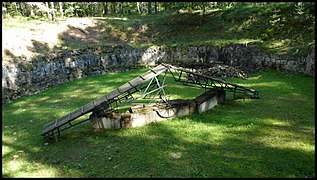 Pit used to burn corpses that were exhumed to destroy evidence of mass murders.
Pit used to burn corpses that were exhumed to destroy evidence of mass murders.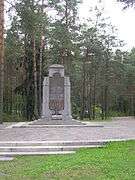 Memorial for Jewish victims.
Memorial for Jewish victims.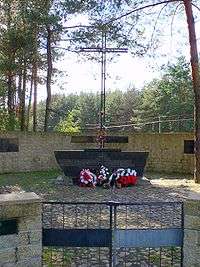 Memorial for Polish victims.
Memorial for Polish victims.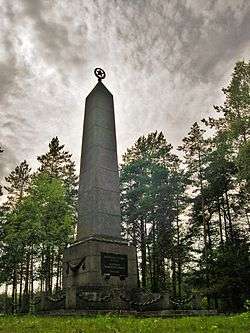 Memorial for Soviet victims.
Memorial for Soviet victims. An excavated pit used to cremate corpses
An excavated pit used to cremate corpses
See also
Footnotes
- ↑ Unlike the Jews of sovereign Lithuania before 1939 (or the Generalbezirk Litauen after Operation Barbarossa), who had their own complex identity and could be described retroactively as either Polish, Lithuanian or Russian,[6] the Jews of the Wilno region were citizens of sovereign Poland before the Nazi-Soviet invasion of September 1939; and thousands of refugees from German-occupied Poland kept arriving.[7] In October 1939 the city was handed over to Lithuania. On the eve of its Soviet annexation in June 1940, Vilna was home to around 100,000 newcomers, including 85,000 Poles, 10,000 Jews, and 5,000 Belorussians and Russians.[8] Ethnic Lithuanians represented less than 0.7 percent of the inhabitants of the city.[9][p. 4]
- ↑ According to Miller-Korpi (1998), one of the areas to first experience the totality of Hitler’s "Final Solution" for the Jews were the Baltic countries.[11] Her opinion nevertheless was challenged by Dr. Samuel Drix (Witness to Annihilation), and Jochaim Schoenfeld (Holocaust Memoirs) who argued that the Final Solution began in Distrikt Galizien.
Citations
- 1 2 3 KŚZpNP (2003). "Investigation of the mass murder of Poles in 1941–1944 at Ponary near Wilno by functionaries of German police and the Lithuanian collaborationist forces" [Śledztwo w sprawie masowych zabójstw Polaków w latach 1941-1944 w Ponarach koło Wilna dokonanych przez funkcjonariuszy policji niemieckiej i kolaboracyjnej policji litewskiej]. Documents of the ongoing investigation (in Polish). Institute of National Remembrance – via Internet Archive, 17 October 2007.
- 1 2 3 4 5 6 7 8 9 Michalski, Czesław. "Ponary — the Golgotha of Wilno" [Ponary - Golgota Wileńszczyzny] (in Polish). Konspekt nº 5, Winter 2000–01, Academy of Pedagogy in Kraków – via Internet Archive, 24 December 2008.
- 1 2 Kazimierz Sakowicz, Yitzhak Arad, Ponary Diary, 1941–1943: A Bystander's Account of a Mass Murder, Yale University Press, 2005, ISBN 0-300-10853-2, Google Print.
- 1 2 3 4 Ponary. Last accessed on 10 February 2007.
- 1 2 Bubnys, Arūnas (2004). German and Lithuanian Security Police, 1941–44 [Vokiečių ir lietuvių saugumo policija] (in Lithuanian). Vilnius: Lietuvos gyventojų genocido ir rezistencijos tyrimo centras. Retrieved 9 June 2006.
- ↑ Mendelsohn, Ezra (1993). On Modern Jewish Politics. Oxford University Press. p. 8. ISBN 0-19-508319-9. Also in: Abley, Mark (2003). Spoken Here: Travels Among Threatened Languages. Houghton Mifflin Books. pp. 205, 277–279. ISBN 0-618-23649-X.
- 1 2 Balkelis (2013), p. 248, 'Red Cross'.
- ↑ Balkelis, Tomas (2013). Omer Bartov; Eric D. Weitz, eds. Nationalizing the Borderlands. Shatterzone of Empires: Coexistence and Violence in the German, Habsburg, Russian, and Ottoman Borderlands. pp. 246–252. ISBN 0253006317.
- 1 2 Niwiński, Piotr (2011). Ponary : the Place of "Human Slaughter" (in Polish, English, and Lithuanian). Warsaw: Instytut Pamięci Narodowej, Komisja Ścigania Zbrodni przeciwko Narodowi Polskiemu; Ministerstwo Spraw Zagranicznych Rzeczpospolitej Polskiej, Departament Współpracy z Polonią. pp. 25–26.
- 1 2 Piotrowski, Tadeusz (1997). Poland's Holocaust. McFarland & Company. p. 168. ISBN 0-7864-0371-3.
- ↑ Miller-Korpi, Katy (1998). The Holocaust in the Baltics. University of Washington, Department papers online. Internet Archive, March 7, 2008.
- 1 2 3 4 5 6 Snyder, Timothy. The Reconstruction of Nations: Poland, Ukraine, Lithuania, Belarus, 1569-1999. Yale University Press. pp. 84–89. ISBN 0-300-10586-X – via Google Books, preview.
- ↑ Sedlis, Steven P.; Grodin, Michael A. (2014). The Establishment of a Public Health Service in the Vilna Ghetto. Jewish Medical Resistance in the Holocaust. Berghahn Books. p. 148. ISBN 1782384189.
- 1 2 Baumel, Judith Tydor; Laqueur, Walter (2001). The Holocaust Encyclopedia. Yale University Press. p. 254. ISBN 0300138113. Also in: Shapiro, Robert Moses (1999). Holocaust Chronicles: Individualizing the Holocaust Through Diaries and Other Contemporaneous Personal Accounts. KTAV Publishing House. p. 162. ISBN 0881256307.
- 1 2 Woolfson, Shivaun (2014). Holocaust Legacy in Post-Soviet Lithuania: People, Places and Objects. Bloomsbury Publishing. p. 3. ISBN 1472522958.
- ↑ Miniotaite, Grazina (1999). "The Security Policy of Lithuania and the 'Integration Dilemma'" (PDF). NATO Academic Forum: 21.
- ↑ Snyder, Timothy (2002). Müller, Jan-Werner, ed. Poland, Lithuania and Ukraine, 1939–1999. Memory and Power in Post-War Europe: Studies in the Presence of the Past. Cambridge University Press. p. 47. ISBN 9780521000703.
- ↑ Vilnius Yiddish Institute (2009), The Tour of Ponar, part 1 (3:22 min.) on YouTube. As well as, The Tour of Ponar, part 2 (6:47 min.) on YouTube.
- ↑ Ernst Klee, Willi Dressen, and Volker Riess (1991). "Soldiers from a motorized column watch a massacre in Paneriai, Lithuania". The Good Old Days: The Holocaust as Seen by Its Perpetrators and Bystanders. Free Press. pp. 38–58. ISBN 1568521332.
- ↑ Arad, Yitzhak (1980). "Chapter 13". The Toll of the Extermination Operations (July–December 1941). Ghetto In Flames. KTAV Publishing House. pp. 209–217.
- ↑ (in Russian) (in English) Testimony of Y. Farber, a witness and participant of the event, as recorded by Vasily Grossman and Ilya Ehrenburg in ″The Black Book: The Ruthless Murder of Jews by German-Fascist Invaders Throughout the Temporarily-Occupied Regions of the Soviet Union and in the Death Camps of Poland during the War 1941–1945.″ ( ISBN 0-89604-031-3)
- ↑ NY Times, Escape Tunnel Dug by Hand Is Found at Holocaust Massacre Site, By NICHOLAS ST. FLEUR, JUNE 29, 2016
- ↑ Andrzej Kaczyński, Zbrodnia ponarska w świetle dokumentów Archived February 23, 2014, at the Wayback Machine., wyborcza.pl, 17 June 2009; accessed 8 December 2014.
- ↑ Memorial to the Murdered Jews of Lithuania at Ponary (with photo gallery); accessed 15 March 2007.
- ↑ Mikke, Stanisław. "In Ponary" [W Ponarach]. Adwokatura.pl – via Internet Archive, 2008-02-25. . Message from the Polish-Lithuanian Memorial Ceremony in Panerai, 2000. On the pages of Polish Bar Association.
References
| Wikimedia Commons has media related to Ponary massacre. |
- Ponary – Vilna During the Holocaust on the Yad Vashem website
- Chronicles of the Vilna Ghetto: wartime photographs & documents - vilnaghetto.com
- Ponary Forest at the Wayback Machine (archived April 20, 2006)
- US Holocaust Museum article on death of Vilna's Jews
- RTFT article on death of Vilna's Jews
- holocaustresearchproject
- Yad Vashem interview about Ponar on YouTube.
- Timothy Snyder, Neglecting the Lithuanian Holocaust, NYRBlog, July 25, 2011.
- Tomkiewicz, Monika (2008). Zbrodnia w Ponarach 1941 - 1944 (in Polish). Warszawa: Instytut Pamięci Narodowej. ISBN 978-83-60464-91-5.
- Algis Kasperavičius, ""Lithuanian-Jewish relations in 1935-1944
